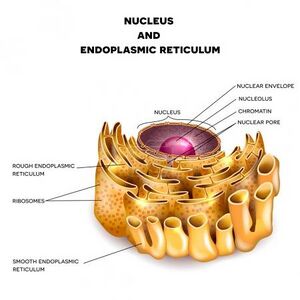Stress of endoplasmic reticulum
The endoplasmic reticulum (ER) stress is a set of all possible influences that lead the endoplasmic reticulum out of homeostasis, which is mainly manifested by the accumulation of proteins that have not undergone the process of protein folding. In response, signaling pathways are triggered that are collectively referred to as the unfolded protein response (UPR). As a result, mRNA translation slows, malfolded proteins are degraded, chaperone gene expression increases, and the oxidative environment in the ER is maintained. In case of failure of regulatory mechanisms, apoptosis is triggered.
Common ER function[edit | edit source]
Under physiological conditions, the nascent polypeptide is labelled during mRNA translation and the entire ribosome-polypeptide-mRNA complex is sent to the appropriate site in the ER where the polypeptide is completed. N-glycosylation is performed and the oxidative environment of the ER ensures the formation of disulfide bridges
(-SH + HS- → -S-S- + 2 H+ + 2 e-)
If malfolding occurs and the protein is misfolded, it threatens the entire endoplasmic reticulum by inducing the recruitment of other malfolded proteins. This is prevented by the binding of chaperones such as Grp78 (glucose regulated protein), and the protein is thus destined for endoplasmic reticulum associated degradation (ERAD).
Stress signalling pathways[edit | edit source]
- PERK kinase (eIF2 kinase)
- kinase family including Ire1 - triggers two forms of response:
- Expression of chaperone genes, including Grp78, to ensure that proteins remain in an unfolded state and no malfolding occurs; expression occurs through translation of the mRNA of the transcription factor XBP1
- binding and retention of Ca2+ in the ER
- transcription factor ATF6 (activating transcription factor) - influences XBP1 mRNA expression
Initiation of apoptosis[edit | edit source]
It is not yet properly explained, two routes are assumed, using:
- transcription factors, presumably Ire1 could upregulate the transcription factor GADD153/CHOP, which affects the balance between Bcl-2 and Bax;
- caspases, possibly casp-12.
Links[edit | edit source]
Related articles[edit | edit source]
References[edit | edit source]
- JONÁK, Jiří. Sbalování proteinů a jeho poruchy, onemocnění spojená s poruchami sbalování a agregací bílkovin [přednáška k předmětu Patobiochemie 3, obor VL, 1. lékařská Univerzita Karlova]. Praha. 11.12.2015.
Used literature[edit | edit source]
- SZEGEZDI, Eva. Molecular mechanism of ER stress [online]. [cit. 2011-02-01]. <http://www.nuigalway.ie/biochemistry/staff/samali/lab/EvaSzegezdi.html>.
- Wikipedia contributors. Unfolded protein response [online]. [cit. 2011-02-01]. <https://en.wikipedia.org/w/index.php?title=Unfolded_protein_response&oldid=398120351>.

